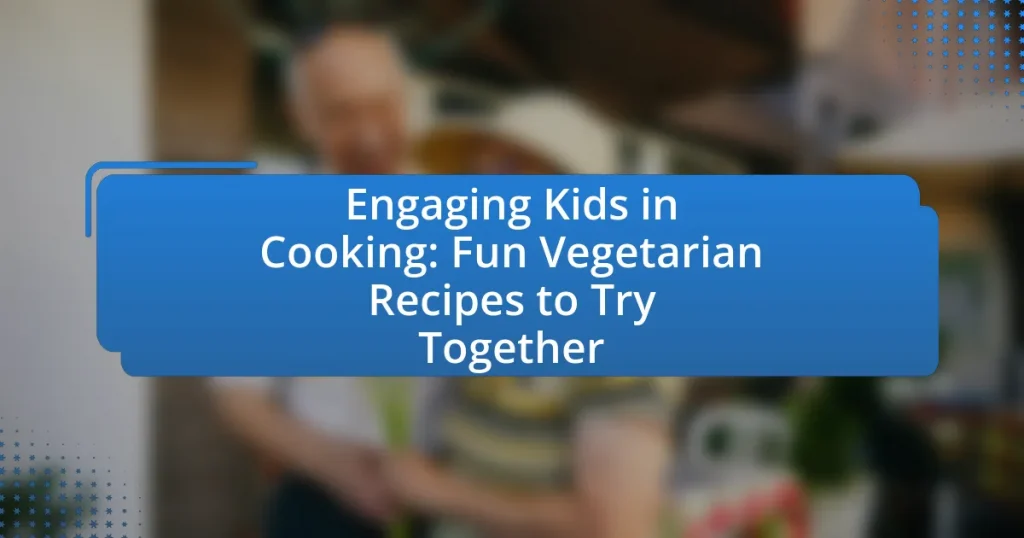Engaging kids in cooking is a valuable practice that involves children in meal preparation, fostering their interest in food and nutrition while teaching essential cooking skills. This article explores the importance of involving children in cooking, highlighting the development of life skills, teamwork, and healthy eating habits. It discusses the benefits of vegetarian cooking, including improved nutrition and environmental impact, and provides fun, easy vegetarian recipes for families to try together. Additionally, the article addresses safety tips, strategies for keeping kids engaged, and ways to handle challenges such as picky eaters, ensuring a positive cooking experience for children.

What is Engaging Kids in Cooking?
Engaging kids in cooking involves actively involving children in the preparation and cooking of meals, fostering their interest in food and nutrition. This practice not only teaches essential cooking skills but also encourages creativity, teamwork, and healthy eating habits. Research indicates that children who participate in cooking activities are more likely to try new foods and develop a positive attitude towards healthy eating. For example, a study published in the Journal of Nutrition Education and Behavior found that children who engaged in cooking classes showed increased fruit and vegetable consumption.
Why is it important to involve kids in cooking?
Involving kids in cooking is important because it fosters essential life skills and promotes healthy eating habits. When children participate in meal preparation, they learn about nutrition, develop cooking techniques, and gain confidence in their abilities. Research indicates that children who help in the kitchen are more likely to try new foods and make healthier food choices, as evidenced by a study published in the Journal of Nutrition Education and Behavior, which found that children who engage in cooking activities are more inclined to consume fruits and vegetables. Additionally, cooking together strengthens family bonds and enhances communication skills, making it a valuable activity for both personal development and family dynamics.
What skills do children develop through cooking?
Children develop various skills through cooking, including fine motor skills, math skills, reading comprehension, and teamwork. Fine motor skills are enhanced as children chop, mix, and measure ingredients, which improves their hand-eye coordination and dexterity. Math skills are developed through measuring ingredients and understanding proportions, which helps them grasp basic arithmetic concepts. Reading comprehension is improved as children follow recipes, learning to interpret instructions and expand their vocabulary. Additionally, cooking fosters teamwork and communication skills when children collaborate with others in the kitchen, promoting social interaction and cooperation. These skills are essential for their overall development and can positively impact their academic performance and social relationships.
How does cooking together strengthen family bonds?
Cooking together strengthens family bonds by fostering communication and collaboration among family members. When families engage in the cooking process, they share responsibilities, discuss meal choices, and work together to create a dish, which enhances their connection. Research indicates that shared family meals can improve relationships and promote a sense of belonging, as families who cook together often report higher levels of satisfaction and unity. Additionally, cooking together allows for the transmission of cultural traditions and family recipes, further solidifying familial ties.
What are the benefits of vegetarian cooking for kids?
Vegetarian cooking for kids offers numerous benefits, including improved nutrition, enhanced cooking skills, and increased awareness of healthy eating habits. A diet rich in fruits, vegetables, whole grains, and legumes provides essential vitamins, minerals, and fiber, which are crucial for children’s growth and development. Research indicates that children who consume plant-based diets tend to have lower risks of obesity, heart disease, and type 2 diabetes due to the lower saturated fat content and higher nutrient density of vegetarian foods. Additionally, engaging kids in vegetarian cooking fosters creativity and teamwork, as they learn to prepare meals together, which can strengthen family bonds and make healthy eating more enjoyable.
How does a vegetarian diet contribute to health?
A vegetarian diet contributes to health by reducing the risk of chronic diseases and promoting overall well-being. Research indicates that individuals following a vegetarian diet often have lower cholesterol levels, reduced blood pressure, and a lower risk of heart disease, type 2 diabetes, and certain cancers. For instance, a study published in the Journal of the American Dietetic Association found that vegetarians typically have a lower body mass index (BMI) and better nutrient intake, including higher levels of dietary fiber, vitamins, and antioxidants. These factors collectively enhance health outcomes and support a balanced lifestyle.
What environmental benefits come from vegetarian cooking?
Vegetarian cooking significantly reduces environmental impact by lowering greenhouse gas emissions, conserving water, and preserving biodiversity. The production of plant-based foods generates fewer emissions compared to meat, with livestock accounting for approximately 14.5% of global greenhouse gases, according to the Food and Agriculture Organization. Additionally, vegetarian diets require less water; for instance, producing one pound of beef requires about 1,800 gallons of water, while vegetables and grains require substantially less. Furthermore, vegetarian cooking supports biodiversity by reducing the demand for land used for livestock grazing, which often leads to deforestation and habitat loss.

What Fun Vegetarian Recipes Can We Try Together?
Fun vegetarian recipes to try together include vegetable stir-fry, homemade veggie pizzas, and stuffed bell peppers. Vegetable stir-fry allows for creativity with colorful vegetables and can be customized with different sauces, making it engaging for kids. Homemade veggie pizzas enable children to choose their toppings, fostering decision-making and creativity. Stuffed bell peppers can be filled with a mixture of rice, beans, and spices, providing a hands-on cooking experience that teaches kids about healthy ingredients. These recipes not only promote cooking skills but also encourage healthy eating habits.
What are some easy vegetarian recipes for kids?
Easy vegetarian recipes for kids include vegetable quesadillas, mini veggie pizzas, and fruit and yogurt parfaits. Vegetable quesadillas can be made by filling tortillas with cheese and assorted vegetables like bell peppers and spinach, then grilling until crispy. Mini veggie pizzas involve using whole grain English muffins topped with tomato sauce, cheese, and various vegetables, baked until the cheese melts. Fruit and yogurt parfaits consist of layering yogurt with fresh fruits and granola, making a nutritious and visually appealing snack. These recipes are simple, require minimal cooking skills, and encourage kids to participate in the cooking process.
How can we make vegetable pizza together?
To make vegetable pizza together, start by gathering ingredients such as pizza dough, tomato sauce, cheese, and a variety of vegetables like bell peppers, onions, mushrooms, and spinach. Each person can roll out the dough, spread the sauce, sprinkle cheese, and add their choice of vegetables. This collaborative process not only makes cooking fun but also encourages creativity and teamwork. Engaging in this activity can enhance children’s cooking skills and foster a love for healthy eating.
What ingredients do we need for a colorful veggie stir-fry?
To create a colorful veggie stir-fry, you need bell peppers, broccoli, carrots, snap peas, and red cabbage. These ingredients provide a vibrant mix of colors and textures, making the dish visually appealing and nutritious. Bell peppers come in various colors, including red, yellow, and green, while broccoli adds a rich green hue. Carrots contribute an orange shade, snap peas offer a bright green contrast, and red cabbage introduces a deep purple tone. This combination not only enhances the visual aspect of the stir-fry but also ensures a variety of vitamins and minerals essential for a healthy diet.
How can we make cooking more engaging for kids?
To make cooking more engaging for kids, involve them in the entire process by assigning age-appropriate tasks that spark their interest. For example, younger children can help with washing vegetables, while older kids can assist in measuring ingredients or stirring mixtures. Research indicates that hands-on involvement enhances learning and retention, making the cooking experience enjoyable and educational. A study published in the Journal of Nutrition Education and Behavior found that children who participate in cooking activities are more likely to try new foods and develop healthier eating habits.
What roles can kids take on during the cooking process?
Kids can take on various roles during the cooking process, including measuring ingredients, washing vegetables, stirring mixtures, and setting the table. These tasks allow children to actively participate and learn essential cooking skills. For instance, measuring ingredients helps develop math skills, while washing vegetables teaches them about food safety and hygiene. Engaging in these activities fosters a sense of responsibility and boosts their confidence in the kitchen.
How can we incorporate games or challenges into cooking?
Incorporating games or challenges into cooking can be achieved by creating themed cooking competitions, such as a “Chopped” style challenge where participants must use a set of mystery ingredients to create a dish. This approach not only makes cooking fun but also encourages creativity and teamwork among participants. Research indicates that gamifying cooking activities can enhance engagement and learning, particularly for children, as it transforms the cooking process into an interactive experience that fosters skills like problem-solving and collaboration.

How Can We Ensure a Positive Cooking Experience?
To ensure a positive cooking experience, create an engaging and supportive environment that encourages creativity and collaboration. Involving children in the cooking process fosters their interest and builds confidence, making it a fun activity rather than a chore. Research indicates that children who participate in cooking are more likely to try new foods and develop healthier eating habits. For instance, a study published in the Journal of Nutrition Education and Behavior found that children who engaged in cooking activities showed increased willingness to taste and consume fruits and vegetables. Therefore, providing age-appropriate tasks, using simple vegetarian recipes, and celebrating successes can significantly enhance the cooking experience for kids.
What safety tips should we follow when cooking with kids?
When cooking with kids, it is essential to prioritize safety by implementing specific guidelines. First, always supervise children closely to prevent accidents, as studies show that adult supervision significantly reduces kitchen-related injuries among children. Second, teach kids about kitchen hazards, such as hot surfaces and sharp utensils, to foster awareness and caution. Third, ensure children use age-appropriate tools; for instance, younger kids can use plastic knives for cutting soft foods, which minimizes the risk of injury. Fourth, establish a clean workspace by keeping floors free of spills and clutter, as a tidy environment decreases the likelihood of slips and falls. Lastly, emphasize the importance of handwashing before and after handling food to prevent foodborne illnesses, as proper hygiene is crucial in food preparation.
How can we teach kids about kitchen safety?
To teach kids about kitchen safety, start by explaining the importance of safety rules, such as washing hands, using utensils properly, and being aware of hot surfaces. Engaging children in discussions about potential hazards, like sharp knives and hot stoves, reinforces their understanding. Research indicates that children who participate in cooking activities with safety guidance are more likely to retain safety knowledge and apply it in real situations. For example, a study published in the Journal of Nutrition Education and Behavior found that hands-on cooking experiences significantly improved children’s safety awareness in the kitchen.
What tools are safe and suitable for children to use?
Safe and suitable tools for children to use in cooking include child-safe knives, measuring cups, mixing bowls, and silicone baking mats. Child-safe knives are designed with rounded edges to prevent cuts, while measuring cups and mixing bowls help children learn about portion sizes and mixing ingredients safely. Silicone baking mats provide a non-stick surface that is easy to clean and reduces the risk of burns compared to metal pans. These tools are specifically designed to enhance safety and encourage engagement in cooking activities for children.
What are some common challenges when cooking with kids?
Common challenges when cooking with kids include safety concerns, limited attention spans, and varying skill levels. Safety is a primary issue, as children may not be aware of hazards like sharp knives or hot surfaces, necessitating constant supervision. Attention spans can be short, leading to difficulties in completing tasks or following recipes, which can frustrate both the child and the adult. Additionally, children’s cooking skills often vary widely, making it challenging to assign age-appropriate tasks that match their abilities. These factors can complicate the cooking process and require careful planning and patience from the adult involved.
How can we handle picky eaters during cooking sessions?
To handle picky eaters during cooking sessions, involve them in the meal preparation process by allowing them to choose ingredients and participate in cooking tasks. Research shows that children are more likely to try new foods when they have a role in making them, as it increases their interest and investment in the meal. For example, a study published in the Journal of Nutrition Education and Behavior found that children who helped prepare meals were more willing to taste and enjoy the foods they helped create.
What strategies can we use to keep kids focused and engaged?
To keep kids focused and engaged in cooking, incorporate hands-on activities that allow them to participate actively in the process. Engaging children in tasks such as measuring ingredients, stirring mixtures, or decorating dishes fosters their involvement and maintains their interest. Research indicates that children are more likely to stay engaged when they have specific roles and responsibilities, as this promotes a sense of ownership and accomplishment. For example, a study published in the Journal of Nutrition Education and Behavior found that children who actively participated in cooking activities were more likely to try new foods and develop healthier eating habits.
What are some tips for successful cooking sessions with kids?
To ensure successful cooking sessions with kids, involve them in age-appropriate tasks that match their skill levels. For example, younger children can wash vegetables and stir ingredients, while older kids can handle chopping and measuring. This approach not only keeps them engaged but also teaches them valuable cooking skills. Research indicates that children who participate in cooking are more likely to try new foods and develop healthier eating habits. A study published in the Journal of Nutrition Education and Behavior found that cooking with children increases their willingness to taste and enjoy a variety of foods.


